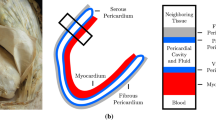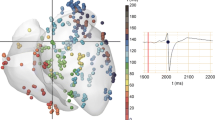Abstract
The analytic, eccentric spheres model of the torso was used to examine the validity of approximating the ‘infinite medium’ potential by integrating ‘finite medium potentials’ over the torso surface. Although idealized, the analytic model is sophisticated enough for all important torso conductivity and geometry parameters to be preserved in the formulation. The model generates both ‘finite medium’ potentials (for which the torso is surrounded by air) and also ‘infinite medium’ potentials (for which the outermost layer of the torso extends outward to infinity). The finite medium torso potentials were integrated over the torso surface in accordance with the approximation used by many investigators in an effort to make the surface distribution more representative of the primary cardiac sources. The resulting potential distribution was compared with the true infinite medium potential, in which the effects of internal inhomogeneities (secondary sources) were taken into account. The difference between the two representations was found to be significant, and caution should be used when interpreting such data.
Similar content being viewed by others
Literature
Gabor, D. and C. V. Nelson. 1954. “Determination of the Resultant Dipole of the Heart from Measurements on the Body Surface.”J. appl. Phys. 25, 413–416.
Geselowitz, D. B. 1960. “Multipole Representation for an Equivalent Cardiac Generator.”Proc. IRE January, 75–79.
—. 1976. “Determination of Multipole Components.” InThe Theoretical Basis for Electrocardiography, C. B. Nelson and D. B. Geselowitz (Eds), pp. 202–212. Oxford: Oxford University Press.
Gulrajani, R. M., H. Pham-Huy, R. A. Nadeau, P. Savard, J. deGuise, R. E' Primeau and F. A. Roberge. 1984. “Application of the Single Moving Dipole Inverse Solution to the Study of the Wolff-Parkinson-White Syndrome in Man.”J. Electrocardiol. 17, 271–288.
Horacek, B. M. and T. J. Montague. 1982. “A Noise-reduction Method Applicable in Body-surface Potential Mapping.” IEEE-ACEMB Conference, Philadelphia.
Kramer, D. A., R. L. Hamlin and H. R. Weed. 1984. “Effects of Pericardial Effusates of Various Conductivities on Body Surface Potentials in Dogs: Documentation of the Eccentric Spheres Model.”Circulation Res. 55, 788–795.
Martin, R. O. and T. C. Pilkington. 1972. “Unconstrained Inverse Electrocardiography: Epicardial Potentials.”IEEE Trans. biomed Engng BME-19, 276–285.
Pilkington, T. C. and R. Plonsey (Eds). 1982Engineering Contributions to Biophysical Electrocardiography. New York: IEEE Press.
—, R. C. Barr and C. L. Rogers 1967. “Effect of Conductivity Interfaces.”Bull. math. Biophys. 29, 705–710.
—— and —. 1968. “Effect of Conductivity Interfaces in Electrocardiography.”Bull. math. Biophys. 30, 637–643.
Plonsey, R. 1974. “On the Effect of the Torso Boundary on Surface Maps.” InBody Surface Mapping of Cardiac Fields, Adv. Cardiol. 10, 58–63.
Rudy, Y. and R. Plonsey. 1979. “The Eccentric Spheres Model as the Basis for a Study of the Role of Geometry and Inhomogeneities in Electrocardiography.”IEEE Trans. biomed. Engng BME-26, 392–399.
Rudy, Y. and R. Plonsey. 1980. “A Comparison of Volume Conductor and Source Geometry Effects on Body Surface and Epicardial Potentials.”Circulation Res. 46, 283–291.
—— and J. Liebman. 1979. “The Effects of Variations in Conductivity and Geometrical Parameters on the Electrocardiogram, Using an Eccentric Spheres Model.”Circulation Res. 44, 104–111.
—, R. Wood and J. Liebman. 1981. “The Effect of High Lung Conductivity on Electrocardiographic Potentials.”Circulation 65, 440–445.
Rush, S., J. A. Abildskov and R. McFee. 1963. “Resistivity of Body Tissues at Low Frequencies.”Circulation Res. 12, 40–50.
Savard, P., F. A. Roberge, J.-B. Perry and R. A. Nadeau. 1980. “Representation of Cardiac Electrical Activity by a Moving Dipole for Normal and Ectopic Beats in the Intact Dog.”Circulation Res. 46, 415–425.
Scher, A. M., W. W. Ohm, W. G. L. Kerrick, S. M. Lewis and A. C. Young. 1971. “Effects of Body Surface Boundary and of Tissue Inhomogeneity on the Electrocardiogram of the Dog.”Circulation Res. 29, 600–609.
Schwan, H. P. and C. F. Kay. 1956. “Specific Resistance of Body Tissues.”Circulation Res. 4, 664–670.
Tanaka, H., K. Yajima, T. Ihara and T. Furukawa. 1980. “An Inverse Solution in Electrocardiology—Estimation of Epicardial Potential Mapping using Spheroidal Harmonics.”Proc. 3rd World Conference on Informatics, Tokyo, Lindberg Kaihara (Ed.), pp. 254–258. Amsterdam: North-Holland.
——— and —. 1982. “An Inverse Solution of Electrocardiology—Epicardial Potential Estimation by Using the Orthogonal Expansion Method.”Japan. Heart J. 23 (Suppl.), 352–354.
Author information
Authors and Affiliations
Rights and permissions
About this article
Cite this article
Messinger-Rapport, B.J., Rudy, Y. Effects of the torso boundary and internal conductivity interfaces in electrocardiography: An evaluation of the ‘Infinite medium’ approximation. Bltn Mathcal Biology 47, 685–694 (1985). https://doi.org/10.1007/BF02460133
Received:
Issue Date:
DOI: https://doi.org/10.1007/BF02460133




